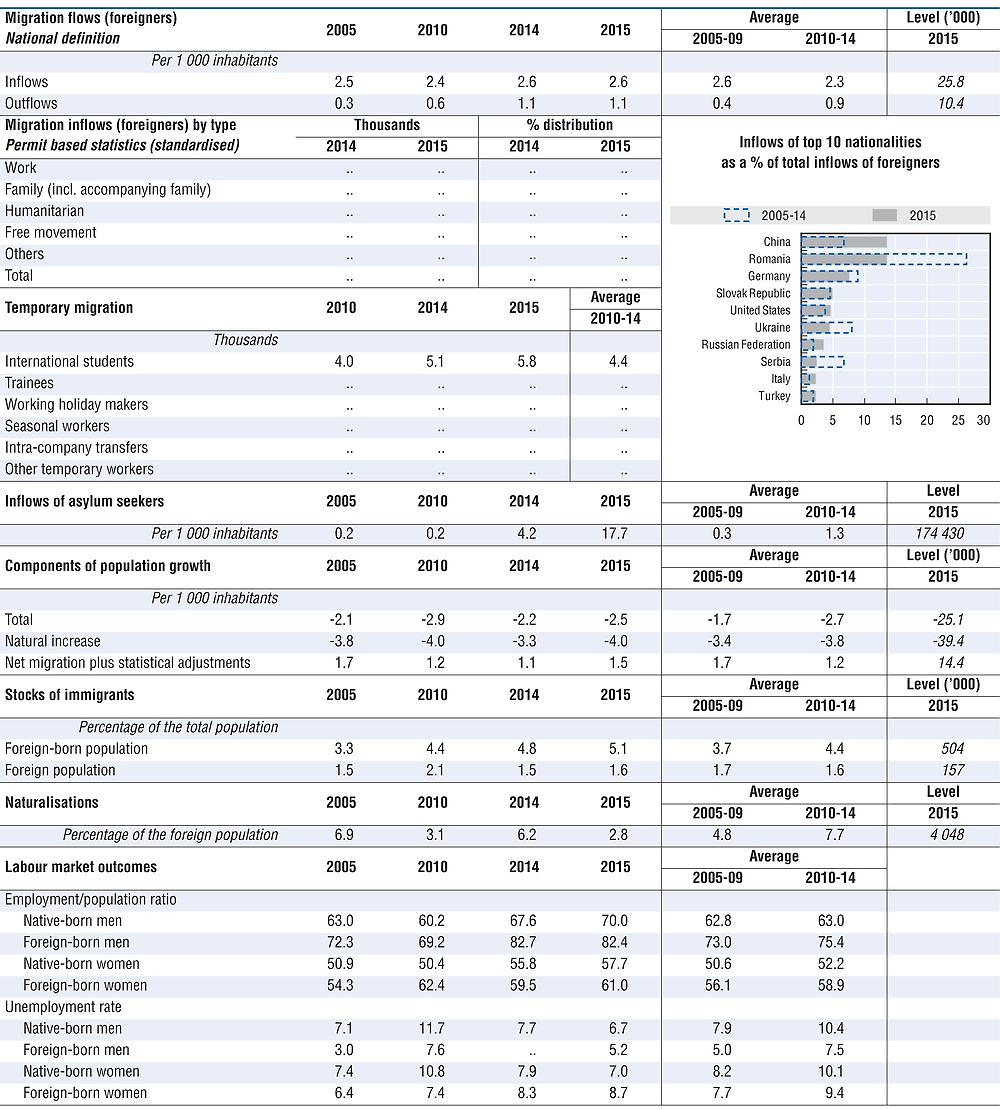Hungary
According to Eurostat, 156 400 foreign nationals resided in Hungary on 1 January 2016, accounting for 1.6% of the total population. This represents a 7% increase on the previous year. The main origin countries were, as in previous years, Romania (29 700), China (19 800) and Germany (19 400).
In 2015, the inflow of foreign nationals to Hungary remained stable at 25 800, still considerably below the 2008 peak of 35 000 entries. At the same time, 10 400 foreign nationals left the country, slightly fewer than in 2014. Taking into account the net outflow of 300 Hungarian nationals, overall net migration stood at +15 000 in 2015. In 2015, a total of 20 800 new residence permits were issued to non-EU/EFTA nationals according to Eurostat, a number similar to that in 2014. Of these, 28% (or 5 900) were issued for the purpose of education to students, mainly from China and Turkey (700 each) and the United States (500). Another 28% (or 5 700, down from 6 700 in 2014) were issued for family reasons. Most new family migrants were Chinese nationals (2 100), followed by Russian and Ukrainian nationals (500 each). Work reasons accounted for 4 200 new residence permits, up from 3 700 the year before. The top nationalities for work reasons were Ukraine (800), China and Serbia (500 each).
Following the introduction of temporary border restrictions after a dramatic increase in the number of asylum seekers registered in Hungary in 2015, asylum applications decreased significantly over the course of 2016. According to Eurostat data, 29 400 asylum claims were filed in 2016, down from 177 100 in 2015. The largest group were Afghan nationals (11 100), followed by Syrians (5 000) and Pakistanis (3 900). A total of 5 100 decisions were taken in 2016, a 50% increase compared with 2015. According to Eurostat data, 400 persons received protection, which is equivalent to a recognition rate of 8%. However almost 49 500 cases were terminated in 2016 due to the absconding of the asylum applicant. In response to the large influx of asylum seekers, several changes were made to the Asylum Act throughout 2015 to simplify and accelerate the asylum procedure. The asylum authority must now decide within 15 days and in cases of judicial review the court has to deliver a decision within 8 days to avoid abuse of the procedure. Further amendments made it possible for asylum seekers to take part in public employment programmes and to register as unemployed and request recruitment services from employment authorities. Moreover, two temporary reception centres were established in the western and one in the southern part of Hungary between July 2015 and March 2016.
In April 2016, the Hungarian prime minister proposed the “Schengen 2.0 Action Plan” to protect EU external borders. The plan foresees more severe consequences for abuse of the asylum system, and stronger enforcement of readmission agreements with countries of origin and transit, as well as return of irregular migrants to safe third or transit countries. Meanwhile, Hungary completed the introduction of the Visa Information System (VIS) at its border crossing points on the external Schengen border. The system gives Hungarian visa-issuing authorities worldwide VIS coverage and access to exchange of visa data among Member States and Schengen Associated Countries.
In October 2016, Hungary held a referendum on the EU plans for a system of mandatory quotas for the admission of refugees. Less than half of the electorate participated in the referendum, rendering the process constitutionally null. Among those who participated more than 98% voted against admission.
Further policy changes concern the admission of high-net-worth investors. As of January 2015 the investment in special state bonds required to gain preferential residence and long-term residence rights in Hungary, was raised from EUR 250 000 to EUR 300 000.
As of January 2017, citizenship matters, previously under the competence of the Office of Immigration and Nationality, fall within the responsibility of the Government Office of the Capital City Budapest. The Office of Immigration and Nationality was renamed “Immigration and Asylum Office”.
As of March 2017, the government is planning to introduce a new amendment of the asylum legislation concerning cases of mass influx to Hungary. The aim of the Hungarian measures is to avoid the uncontrolled secondary movements of third country nationals within the territory of the EU. Asylum seekers will have to wait for a final decision of their asylum requests in the designated transit zones.

